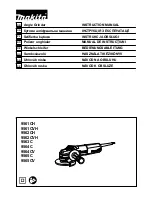
48
Hangar 9 Alpha 40 ARF Assembly Manual
Control Throws
Step 1
Check the battery voltage on both the transmitter and
the receiver battery packs. Do not fly below 4.3V on the
transmitter if you are using a Spektrum transmitter that uses
4-cells to power the transmitter. Do not fly below 9.5V on the
transmitter if you are using a JR or Spektrum transmitter that
uses 8-cells to power the transmitter. Do not fly if the receiver
pack is at or below 4.7V. To do so may crash your aircraft.
Step 2
Check the movement of the elevator with the radio system.
Moving the elevator stick toward the bottom of the
transmitter will make the airplane elevator move up.
Step 3
Check the movement of the ailerons with the radio system.
Moving the aileron stick right will make the right aileron
move up and the left aileron move down.
Step 4
Use a ruler to adjust the throw of the elevator, ailerons
and rudder.
Aileron High Rate
Up
3/8-inch
(10mm)
(14 degrees)
Down
3/8-inch
(10mm)
(14 degrees)
Aileron Low Rate
Up
1/4-inch
(6mm)
(8 degrees)
Down
1/4-inch
(6mm)
(8 degrees)
Elevator High Rate
Up
1/2-inch
(13mm)
(16 degrees)
Down
1/2-inch
(13mm)
(16 degrees)
Elevator Low Rate
Up
5/16-inch
(8mm)
(10 degrees)
Down
5/16-inch
(8mm)
(10 degrees)
Rudder High Rate
Left
7/8-inch
(22mm)
(20 degrees)
Right
7/8-inch
(22mm)
(20 degrees)
Rudder Low Rate
Left
1/2-inch
(13mm)
(11 degrees)
Right
1/2-inch
(13mm)
(11 degrees)
Note
: Measurements are taken at the inner or widest
point on the control surface.
These are general guidelines measured from our own flight
tests. You can experiment with higher rates to match your
preferred style of flying.
Note
: Travel Adjust, Sub-Trim and Dual Rates are
not listed and should be adjusted according to each
individual model and preference.
once all control throws are set, make sure the
safety tubing is slid over the forks of the clevises to
prevent them from opening accidentally in flight.
Maintaining your Model
The following is a check list you should follow every time you
have completed a flying session with your model. Doing so will
keep your aircraft in the best flying condition.
Clean Up
After a long flying session with your model, you will want to
clean it up before loading it into your vehicle to head home.
Use cleaner and a paper towel to wipe down the exterior of
your plane, removing the fuel residue. Remember, a clean
plane will last longer since the fuel won’t be allowed to soak
into any exposed wood.
Checking the Propeller
Check to make sure the propeller is tightly secured to the
engine. If not, remove the spinner and use a crescent wrench
to tighten it back down. If you have had any not-so-great
landings, you will want to inspect the propeller for any
damage. Small nicks and scratches can quickly become
fractures, causing the propeller to be unsafe for flight.
Always carry a few spare propellers so a damaged propeller
can be replaced at the field, increasing your flying time per
trip to the field.
Checking the Clevises
Inspect the aileron, elevator and rudder clevises to make
sure they are connected and in good working order. If you
find a clevis is showing signs of wear or broken, replace it
with a new clevis. Also check the nylon connectors at the
servo for any wear or damage. If they look worn or in bad
shape, replace them as well.
Checking the Control Horns
Inspect the control horns to make sure they have not
crushed the wood of the control surface. If so, remove the
control horn screws to remove the control horn. Place 2–3
drops of thin CA into each of the screw holes. In addition,
use a T-pin to poke small holes in the covering in the area
where the control horn mounts, then saturate the area with
thin CA. This will harden the wood and give the control
horns a solid surface to be mounted to.
Checking the Wheel Collars
Check the setscrews on the wheel collars for the main and
tail wheel to make sure they are not loose. Use a 1.5mm hex
wrench to tighten the setscrews. It is suggested if they loosen
frequently to remove them, apply threadlock to the setscrews,
then secure the wheel collars back into position. The threadlock
and hex wrench are included in the kit for this purpose.







































